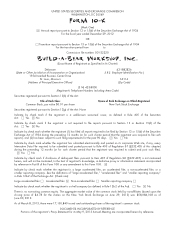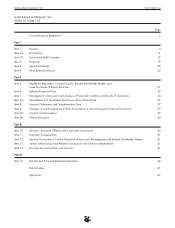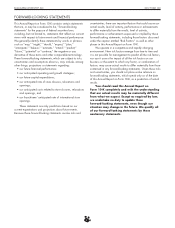Build-A-Bear Workshop 2012 Annual Report Download - page 19
Download and view the complete annual report
Please find page 19 of the 2012 Build-A-Bear Workshop annual report below. You can navigate through the pages in the report by either clicking on the pages listed below, or by using the keyword search tool below to find specific information within the annual report.
BUILD-A-BEAR WORKSHOP, INC. 2012 FORM 10-K
SEC’s Public Reference Room at 100 F Street, N.E.,
Washington, D.C. 20549 or by calling 1-800-SEC-0330.
Also, these filings are available on the internet at
http://www.sec.gov. Our Annual Reports to shareholders,
press releases and investor updates are also available on
our website, free of charge, in the Investor Relations section
or by writing to the Investor Relations department at World
Bearquarters, 1954 Innerbelt Business Center Dr., St. Louis,
MO 63114.
ITEM 1A. RISK FACTORS
We operate in a changing environment that involves
numerous known and unknown risks and uncertainties that
could materially affect our operations. The risks, uncertainties
and other factors set forth below may cause our actual results,
performances or achievements to be materially different from
those expressed or implied by our forward-looking statements.
If any of these risks or events occur, our business, financial
condition or results of operations may be adversely affected.
RISKS RELATED TO OUR BUSINESS
A decline in general global economic conditions could lead
to disproportionately reduced consumer demand for our
products, which represent relatively discretionary spending,
and have an adverse effect on our liquidity and profitability.
Since purchases of our merchandise are dependent upon
discretionary spending by our guests, our financial
performance is sensitive to changes in overall economic
conditions that affect consumer spending. Consumer spending
habits are affected by, among other things, prevailing
economic conditions, levels of employment, salaries and
wage rates, consumer confidence and consumer perception
of economic conditions. A continued slowdown in the
United States, Canadian or European economies or
uncertainty as to the economic outlook could reduce
discretionary spending or cause a shift in consumer
discretionary spending to other products. Any of these factors
would likely result in lower net sales and could also result in
excess inventories, which could, in turn, lead to increased
merchandise markdowns and related costs associated with
higher levels of inventory and adversely affect our liquidity
and profitability. For example, the slower economy in the
United States and Europe has caused our sales to decline
and led us to slow our growth plans.
A decrease in the customer traffic generated by the shopping
malls in which we are located, which we depend upon to
attract guests to our stores, could adversely affect our
financial condition and profitability.
While we invest heavily in integrated marketing efforts and
believe we are more of a destination location than traditional
retailers, we rely to a great extent on customer traffic in the
malls in which our stores are located. In order to generate
guest traffic, we generally attempt to locate our stores in
prominent locations within high traffic shopping malls. We
rely on the ability of the malls’ anchor tenants, generally large
department stores, and on the continuing popularity of malls
as shopping destinations. We cannot control the development
of new shopping malls, the addition or loss of anchors and
co-tenants, the availability or cost of appropriate locations
within existing or new shopping malls or the desirability,
safety or success of shopping malls. In addition, customer mall
traffic may be reduced due to a loss of consumer confidence
because of the economy, terrorism or war. If we are unable
to generate sufficient guest traffic, our sales and results of
operations will be harmed. A significant decrease in shopping
mall traffic could have a material adverse effect on our
financial condition and profitability. For example, we have
experienced a decline in transactions at comparable locations
over the past several years.
If we are unable to generate interest in and demand for our
interactive retail experience, including being able to identify
and respond to consumer preferences in a timely manner,
our financial condition and profitability could be adversely
affected.
We believe that our success depends in large part upon our
ability to continue to attract guests with our interactive
shopping experience and our ability to anticipate, gauge
and respond in a timely manner to changing consumer
preferences and fashion trends. We cannot assure you that
our past success will be sustained or there will continue to be
a demand for our “make-your-own stuffed animal” interactive
experience, or for our stuffed animals, animal apparel and
accessories. A decline in demand for our interactive shopping
experience, our animals, animal apparel or accessories, or a
misjudgment of consumer preferences or fashion trends, could
have a negative impact on our business, financial condition
and results of operations. For example, in 2008 we
announced plans to close the Friends 2B Made concept. The
closure was completed by the end of the fiscal 2009 third
quarter with pre-tax charges totaling $3.9 million. In addition,
if we miscalculate the market for our merchandise or the
purchasing preferences of our guests, we may be required to
sell a significant amount of our inventory at discounted prices
or even below costs, thereby adversely affecting our financial
condition and profitability. For example, in 2007, we
wrote-off $1.6 million, net of tax, of inventory, including
excess Shrek®merchandise.
Our future growth and profitability could be adversely
affected if our marketing and online initiatives are not
effective in generating sufficient levels of brand awareness
and guest traffic or if consumer preferences change
significantly.
We continue to update and evaluate our marketing initiatives,
focusing on brand awareness, new product news, timely
promotions and rapidly changing consumer preferences. We
may not be able to successfully engage children in our virtual
11
























